13 Why Do They Have More Than Us?
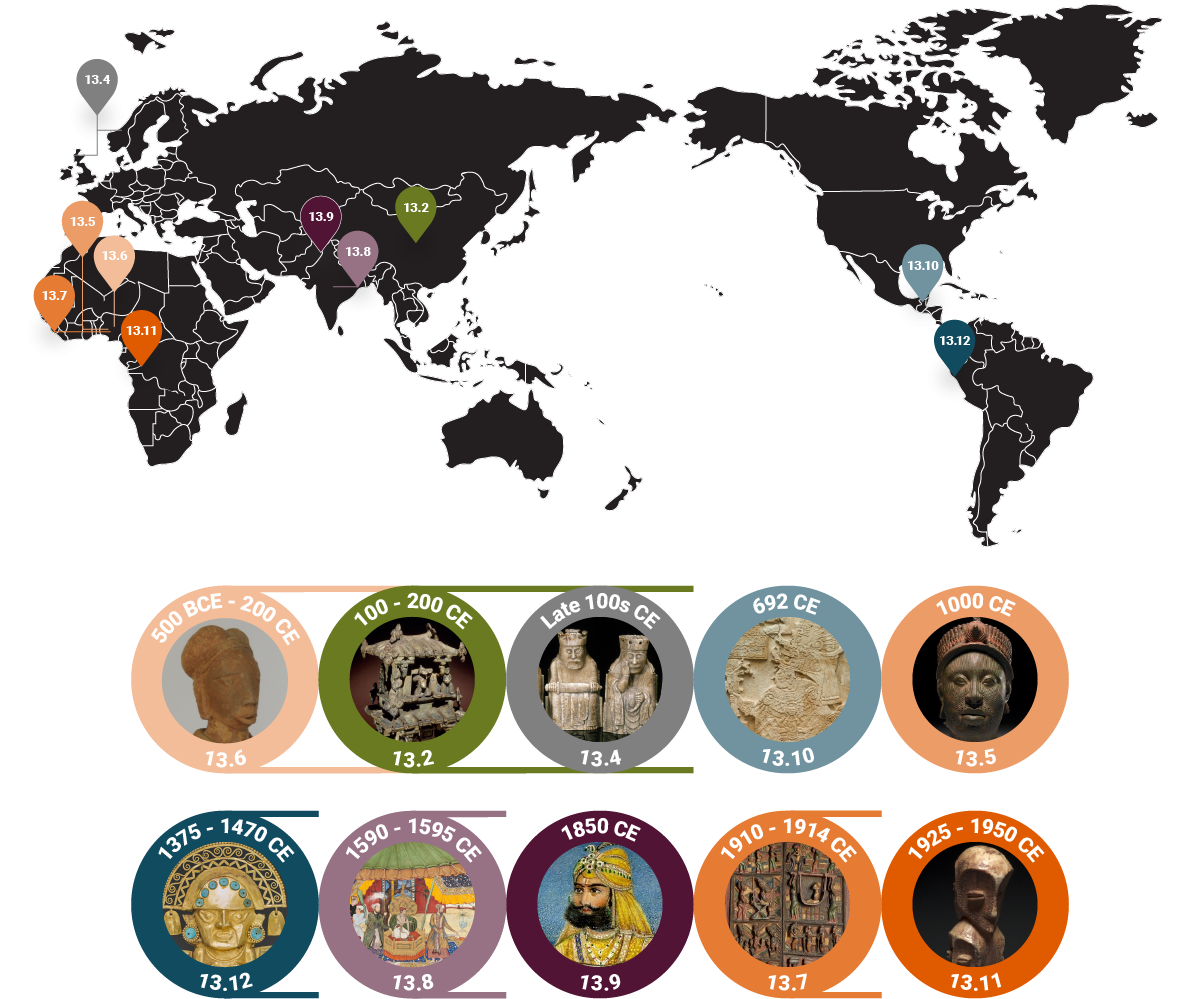
Why do they have more than us?
Remember Shin Suk-ju from the Joseon Dynasty in “Who Am I?” Shin’s rank meant he was high in the social hierarchy, as dictated by the (Neo-)Confucian philosophical and spiritual tradition. Shin had more wealth, status, and power than other people in his society. Like resources and wealth, social status is ‘held’ more by some people in society than others. This status difference, or social disparity, means that some people have more ability to attain their goals than others. Generally speaking, those with higher social status are higher up the social hierarchy and hold more power in society, that is more power to get what they want. History has shown that high status people often seek wealth, notoriety, and more power than they already have. They could also seek prosocial things like equality, peaceful end to conflict, or educational opportunities.
Hierarchies
Neo-Confucianism, based on the earlier Confucian tradition, was all about social order. Confucianism took hold in China in the Han Dynasty, serving as the model for government bureaucracies and the organization of growing populations. Confucianism applied not just to governments but to households and family hierarchies. The Han Dynasty House Model (Fig. 13.2) is a visual representation of familial order and filial piety, structured via the representation of a traditional Han Chinese dwelling. The order of the dwelling (represented by well-built walls, defined decorative features, and the figures that appear to guard the upper story) indicates the order of the family that occupies it. Like many of the ceramic objects we have discussed thus far and those in “What Happens When We Die?”, this model was created as an object for the afterlife, buried with someone so that they would have the same status, luxuries, and order in death.
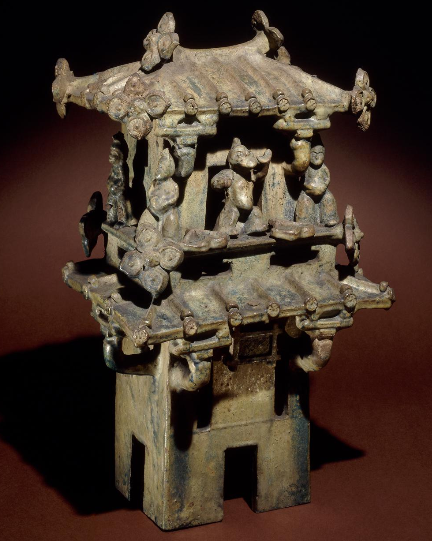
This model also offers a picture of traditional Chinese architecture (TCA), as applied to homes. Remember our discussion of monumental examples of TCA in the Forbidden City in “Why Does Size Matter” and how TCA was used to design pagodas across East Asia in “What Will I Get Out of It?” Those monumental and ceremonial examples would dwarf the two-tiered house represented in the House Model but they use the same architectural principles and style. Notice the simulated ends of bamboo and ridges of the ceramic tile roofs. Notice the projecting eaves and dougong brackets supporting them. Also notice the finials at either side of the uppermost roof ridge and at the corner of each eave. The Taihedian (Hall of Supreme Harmony) in the Forbidden City also sports finials (Fig. 13.3), but what difference do you notice between its finials and those of the House Model?
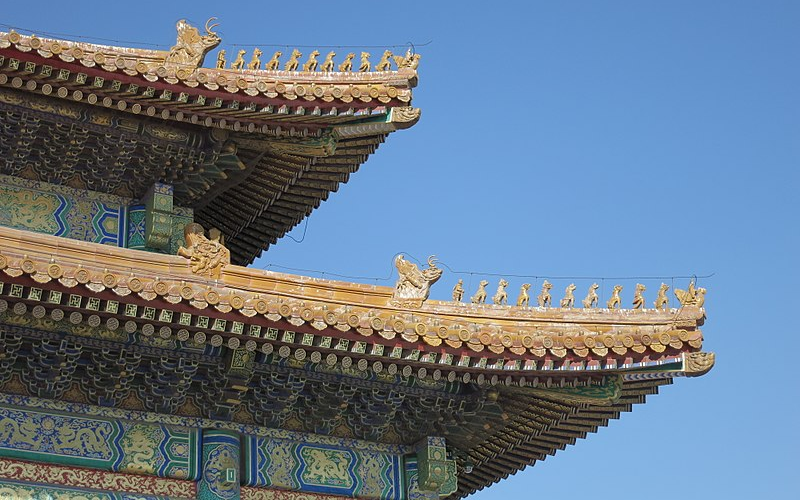
The Taihedian has so many more! In fact, the Taihedian and other structures in the Forbidden City have the most finials on any building. The finials are a representation of status. Households with more status have more roof sculptures. The imperial household has the most of all, over a dozen. House Model has six finials, indicating that the household is not imperial, but still holds status, probably within a smaller community. The other obvious difference you may have noticed is that the House Model finials are floral while the Taihedian finials are figural, representing dragons primarily. This difference also reflects status disparities. Only the Emperor is so directly associated with dragons. Roofs were like billboards, broadcasting the family’s status to the neighbor. This representation of status ensured that all visitors and passersby knew who their neighbors were and how much reverence was expected to maintain Confucian order and hierarchical standards.
Kings at the top
What has been the highest status distinction in most social hierarchies? In patriarchal societies (those in which men hold leadership positions), the king or emperor sits at the top of the social ladder. Representations of kings and other royalty are not rare. In fact, art history generally focuses on objects made for and about high status people and royalty because that is often what survives from the past. Royal people had the resources to commission high-quality and long-lasting objects, maintained as keepsakes over time. In addition, royalty were frequently depicted as subjects in artworks. Depictions of royalty are prominent in the Western Canon. Just think of all of those portraits of Henry VIII and Louis XIV. The Lewis Chess Set (Fig. 13.4) involves the representation of royalty but has an interesting history linking it to traditions outside Europe.
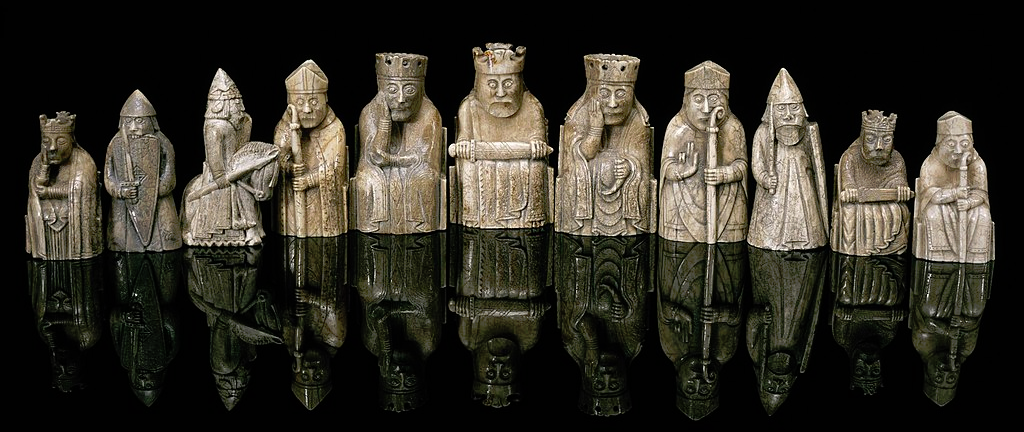
The Lewis Chess Set was found on the isle of Lewis in northern Scotland but was probably made in Norway during the late 1100s CE (Fig 13.1). Unlike most chess sets today, the pieces are not overly abstracted forms focused on headgear. These pieces are figural representations of medieval kings, queens, bishops, and knights. Despite the specific medieval European flavor of this famous set, chess is not a game of European origin. It originated as chaturanga in the 500s CE India, featuring military positions of Padàti or Bhata (foot-soldier; pawn today), Ashva (horse; knight today), Gaja (elephant; bishop today), and Ratha (chariot; rook today). The Raja (king) and Mantri or Senapati (advisor; queen today) were the highly-valued positions, reflecting the social and political hierarchies of the time in India.
Eventually, this game of India was introduced to the Sassanid Persians of present-day Iran (ca. 600 CE). The primary position became the Shah (Persian for “king,” replacing Raja) but gameplay generally remained the same. In the mid-600s CE, Muslim leaders took over Persia and took over this game. By the time Muslims came to control Spain (to be detailed in “Can We Live Together?”), the game, now called shatranj, travelled into Europe. At first, the Christian church enforced prohibitions against chess, because it, like many other games, was linked to gambling. This did not stop the spread of the game. Eventually, the queen position replaced the advisor, reflecting the importance of women leaders in medieval Europe. Christian positions such as the bishop became commonplace, to reflect the necessity of Christian politics in medieval European culture. Over time, chess has taken on an intellectual character, associated with high-status entertainment and sophistication within Western traditions.
Just before the Lewis Chess Set was carved in Norway, the Kingdom of Ife, centered at the city called Ile-Ife (in modern-day Nigeria; Fig 13.1), started to skyrocket in population size and trade around 1000 CE. Like among the Igbo-Ukwu (remember Shell in “What is Beautiful?”), metalworking was an important pursuit, serving both functional needs and aesthetic values in Ife society. Ife metalworkers were recognized for their skill in bronze casting using the lost-wax method. Learn more about West African lost-wax metal casting techniques in “Brass Casting in West Africa” (Dark 1973). Ife artists expertly represented their kings in bronze (and ceramic), as in Portrait of an Ife King with crown (Fig. 13.5).

The king of Ife was the pinnacle of society and humanity. Depicted with fine regalia and strong pose, this king possesses more ase and ewa than anyone else in the kingdom. Ase is one’s energy and power. Ase resides in the head and is expressed through speech. A king’s ase is very potent. Thus, the mouth of a king, and even the mouth of a sculpture representing him, must be covered to protect those lesser than him. The small holes forming a pathway around the king’s mouth and chin were likely used to insert a fabric veil for this purpose. Contemporary leaders of the Yoruba tradition (considered descendants of Ife culture) still shield their faces with veils or beads to ensure that they do not harm others. A king’s ase is spiritual power and is evidence of his divinity. While this object is called a portrait, it may have been created more for a symbolic function: containing the ase of previous kings, to enhance and support the current ruler’s power.
You have probably noticed the deft naturalism of this depiction. In this case, bronze artists focused on idealized naturalism to exemplify the king’s ewa, or true beauty. In Ife society, the king was the model of ewa, defined by high ase, physical beauty, and good character (or iwa). The youthfulness of this rendering with supple skin, full lips, and formal stature demonstrates the goodliness of the leader, through physical traits of his divine being.
Almost a millennia after this bronze was created, a scholar named Leo Frobenius encountered it and many other Ife artworks. Frobenius wrote that Ife sculpture is “[e]loquent, of a symmetry, a vitality, a delicacy of form, directly reminiscent of ancient Greece… It is proof that once upon a time, a race far superior to the negro had settled here” (Frobenius 1913, 88-89). Like those studying Great Zimbabwe in the early 1900s CE, Frobenius suggested that Black Africans, those who lived in Nigeria when he visited, could not have produced such striking naturalism and formal beauty. Instead, he attributed those achievements to Classical Greece. He even suggested that Ife was Atlantis of Greek myth. Ife was not Atlantis. It was a spectacular cultural group uniquely built by Black Africans.
If only Frobenius knew that there was another Black African culture that lived before the Ife, called the Nok in Central Nigeria (Fig. 13.1). Like ‘Sapi,’ ‘Nok’ is a contemporary name attributed to this ancient group; we don’t know what they called themselves. We do know that they produced spectacular terracotta sculptures as early as 500 BCE (contemporaneous with the Classical Greeks). Nok artists represented the elite members of their society in full form, often in crouched or seated positions (Fig. 13.6). These figures sport elaborate coiffures and/or headdresses as well as ornaments at the neck, wrists, and ankles, demonstrating their resources and status. Nok figures often are depicted in very specific postures with specific hand gestures that were likely originally very meaningful, potentially for ritual activities undertaken by elites. There’s much more research to be done on the Nok to understand their society (including whether they had kings, chiefs, or a different kind of political system) and how they relate to later cultures like the Ife.
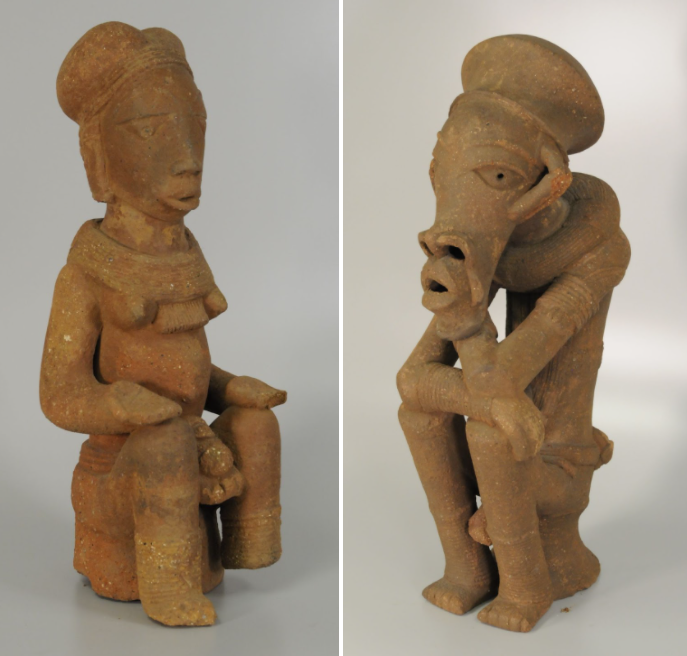
So, Nok came before Ife; what came after Ife? The city of Ile-Ife lives on today, seen as a place of heritage by Yoruba people. For a long time, Yoruba culture thrived as an independent society, eventually meeting European travelers. By the 1880s CE, the British Empire installed official colonial administrators in Yorubaland and other areas of West Africa. The Door for the Afin (Fig. 13.7) represents a visit made by Captain Ambrose of the British military to the Yoruba city of Ikere in 1899 or 1901 CE. Ambrose, with his entourage, was greeted by a Yoruba Ogoga (king). Organized in panels, the left side illustrates the Ogoga and his court and the right side focuses on Captain Ambrose and the people who accompanied him.
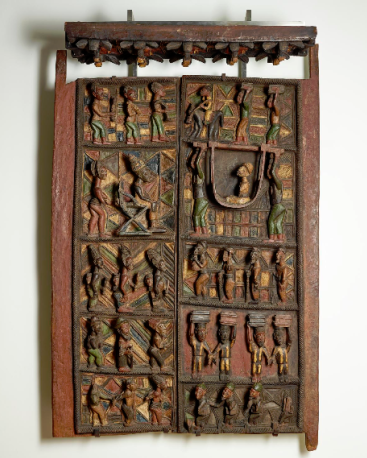
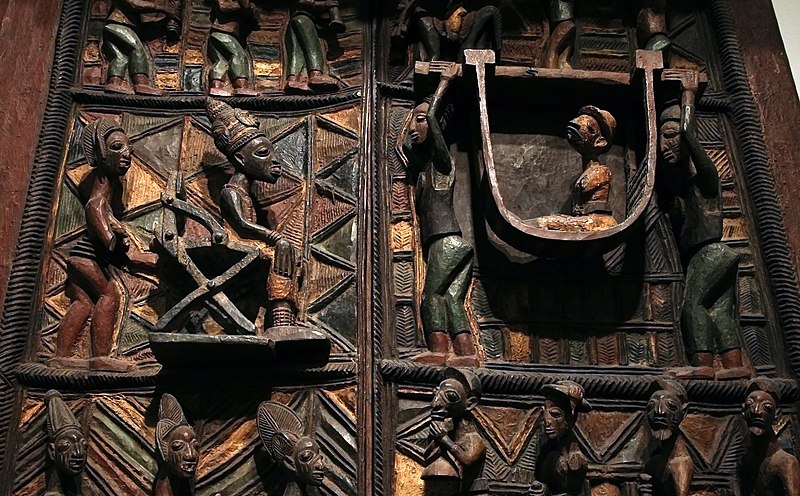
In the second panel on the left side, the Ogoga sits in a traditional chair. Behind him stands his senior wife (wife of highest rank). Above in the first panel are gift-bearers, holding out objects to be presented to the visitor. Below in the third panel, the king’s other wives stand with babies cradled in back slings. The fourth panel probably depicts the Ogoga’s servants while the fifth panel depicts bound prisoners, potentially slaves.
In contrast to the Ogoga, Ambrose is being carried in a litter (a carriage-like transportation method fully supported by people). Above him in the first panel, a mounted figure on horseback leads men carrying packages above their heads, known as porters. Below Ambrose, porters carry more goods. In the fourth panel, pairs of porters are bound at the wrist, with one hand free to secure the boxes they carry. These boxes probably represent the stores of cowrie shells collected as taxes by the British. We see another set of bound prisoners in the bottom panel.
The carver of the Door for the Afin was Olowe of Ise, a high-status Yoruba artist of the late 1800s and early 1900s CE. Over his career, he was commissioned by kings to create monumental arts for their palaces. While created in his workshop by many hands, Olowe’s style is very recognizable. His figures often have elongated features with active postures and textured detail to represent depth in the high relief (see how high in the Fig. 13.7 detail!) Olowe also used distinctive facial features for most figures in his works, focused on large eyes, large noses, and full lips.
This door was created for the entrance to the courtyard of the Afin, the king’s palace. Thus, it was commissioned for a place of prestige and political resonance. What is the message here? This is probably a representation of authority. By the time Olowe carved this door, the British Empire and other European powers controlled nearly all of the continent, but not all in the same ways. Some imperial territory was run through autocracy and foreign domination but the Yoruba had a different arrangement with the British, known as ‘indirect rule.’ Colonial administrators like Captain Ambrose oversaw a number of local leaders, who remained in authority of their own territory but were ultimately answerable to the British. This meant that the Ogoga actually had power. Notice the representation of the Ogoga and Ambrose. The Ogoga sits regally attended in stately formality. Ambrose sits awkwardly in a sort-of hammock and is physically smaller than the Ogoga, appearing almost child-like. This ‘hierarchy of scale’ whereby one figure is represented as larger than another (no matter what body size differences there may have been in real life) clearly demonstrates the Ogoga’s status.
Created by a Yoruba artist for a Yoruba king, the Door for the Afin defies the general colonial landscape of powerless indigenous people and powerful colonial leaders in Africa. Importantly, Olowe made this door for the entrance to the afin (the king’s palace) and thus for the portal through which visitors like Captain Ambrose would access the palace. Most historians and other scholars focus on British colonial records to learn about this period of Yoruba history. Here, we focus on how the Yoruba represented themselves to the colonizers. We’ll consider many other examples of defiance in “Why Do I Have To Do What You Say?”
Beyond the king
Who’s bigger than a king? An Emperor! Emperors rule over empires, distinct from kingdoms because they incorporate many territories through military and diplomatic expansion. Remember the Mughals from “What Happens When We Die?” Babur’s son and successor, Humayun, had a son and successor, Akbar, who came to rule the empire from his capital in present-day India.
Akbar commissioned writers and artists to produce the Akbarnama (stories of Akbar’s reign). The Akbarnama was a manuscript of hundreds of pages, or folios, incorporating calligraphic text and careful illustration. In the folio titled The Young Emperor Akbar Arrests the Insolent Shah Abu’l-Ma’ali (Fig. 13.8), Akbar sits leaning on a large cushion in the golden, hexagonal throne. Akbar is only 13 years old in this story, just months after he became emperor. Beneath and above him, detailed carpets and fabrics cover almost every surface. A landscape in the background is inspired by Safavid painting styles (remember the Safavid Qur’an folio from “What is Beautiful?”). A palatial fort is in the distance with white onion domes, like those soon to be employed in the legendary Taj Mahal (built by Abkar’s grandson, Shah Jahan). The camels and horses just beyond the fabric enclosure draw our eye but not as much as the scene of struggle happening in front of the young emperor.

The man in the orange robe being manhandled by guardsmen is Shah Abu’l-Ma’ali, a member of Humayun’s entourage. Akbar came into power because Humayun battled with maintaining control of his empire. Upon taking the throne, Akbar sought to broadcast his power and his strength in contrast to his father’s perceived weakness. Some did not see these shows of strength in a positive light and began rebelling against Akbar. After Abu’l-Ma’ali oversaw an assassination attempt, he was arrested, brought to court, presented by Akbar’s advisor Bairam Khan (central standing figure), and hanged. The men in the foreground appear to be in chaos, some threatening others with weapons. Such conflicts were common in Akbar’s day. He envisioned a unified Mughal India under his reign. This meant that he conquered independent regions to instill Mughal rulership. Some people didn’t like that.
Another version of the Akbarnama, held at the Victoria and Albert Museum (V&A) in London, illustrates Abu’l-Ma’ali’s final fate. The differences in these manuscript folios illustrate stylistic differences between designers and painters in Mughal imperial workshops. The arrest scene was designed by a famous Mughal artist, Basawan. The V&A example was designed by Jagan, another imperial workshop artist. Both compositions show dynamic forms, with strong action. Both compositions also incorporate figures, architecture, and landscape. Jagan’s work used more saturated colors that give the painting a flatter quality. Basawan employed tints and shades that support the saturated tones of Akbar’s throne, Abu’l-Ma’ali’s robe, the yellow tent fringe, and the deep blues of the carpets. In addition, Basawan created a circular composition, framed by the white fabric enclosure, encircling Akbar and his captive. Jagan’s composition incorporates panels of text, whereas Basawan’s folio highlights the imagery to tell the story. This comparison of two Mughal miniature paintings demonstrates the great variation we find among such paintings.
Mughal rule of India came to an end because of colonization by the British Empire, first initiated by the British-owned East India Company (ca. 1600 CE). As the British gained control of India, surrounding areas were affected, such as the Sikh Empire of Lahore (Fig. 13.1; present-day Pakistan). The Sikh Empire was the political seat of the Sikh religion, a spiritual practice focused on meditation and devotion to the words of God. Sikhs were often at odds with Hindus and Muslims of the region, but the great Mughal leader Akbar was a proponent of religious freedom. When Akbar overtook Lahore, imperial rules allowed the Sihks to maintain their religious traditions. But with Akbar’s death and the accession of his successors Jahangir, Shah Jahan, and Aurangzeb, this changed. Sikh leaders were persecuted, arrested, and killed.
The Mughal Empire slowly declined as the British took hold. This left room for the Sikhs to regain their previous territory and political authority. By the early 1800s CE, the Sikhs had re-established their empire. Depicted in miniature portraits (Fig. 13.9), the Maharaja Sher Singh and his wife ruled the Sikh Empire in the 1840s CE. A little over an inch tall each, these miniatures use similar painting techniques as the larger Akbarnama folios. The detail of the adornments, facial features, and even visible strands of hair reflect the quality of painting and the tiny size of implements such as squirrel hair brushes. Eventually, the British started encroaching on Sikh territory, resulting in the Anglo-Sikh Wars. By 1849 CE, Lahore was under British imperial rule.
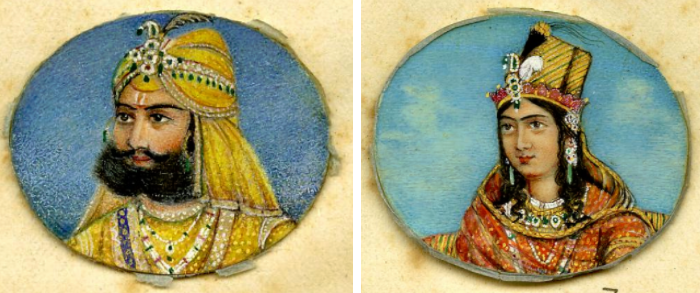
Figure 13.9 right: Company School Maker(s) in Delhi, India. Wife of Maharaja Sher Singh. ca. 1850 CE. Gouache painting on card. The British Museum Collection. CC BY-NC-SA 4.0 © The Trustees of the British Museum.
Did you notice that the Maharaja’s wife is depicted in the same style and glamor as the Maharaja himself? In some societies, queens and empresses, even princesses, can attain the same social status as kings and emperors. In these cases, women take on roles at or very near the top of the social hierarchy. We’ve already discussed the status of women in matrilineal cultures, like the Akan from “Where Do Babies Come From?” Some cultures even follow a matriarchal political structure, wherein women are the primary leaders. For the Maya people of ancient Mesoamerica, women were not the only leaders but they held important political and social positions, often represented in arts in similar ways to kings.
Remember Stela Depicting Kaloomte’ K’abel (Fig. 8.4/13.10) from “Who Came Before Us?” In that chapter, we focused on the calendar dates present in the stela. Now, let’s focus on the lady! Known in English as Lady Waterlily-Hand, Kaloomte’ K’abel was a royal princess of Calakmul (present-day Mexico) and became queen of El Perú-Waka’ (Fig. 13.1) by marriage to K’inich Bahlam II. She ruled with him for 20 years as a military governor and earned the title Kaloomte’ (Supreme Warrior). This probably meant that she held more political authority than her husband. A burial that is thought to be the resting place of Kaloomte’ K’abel was found at El Perú-Waka’ with robust skeletal remains providing evidence for her abilities as a warrior.
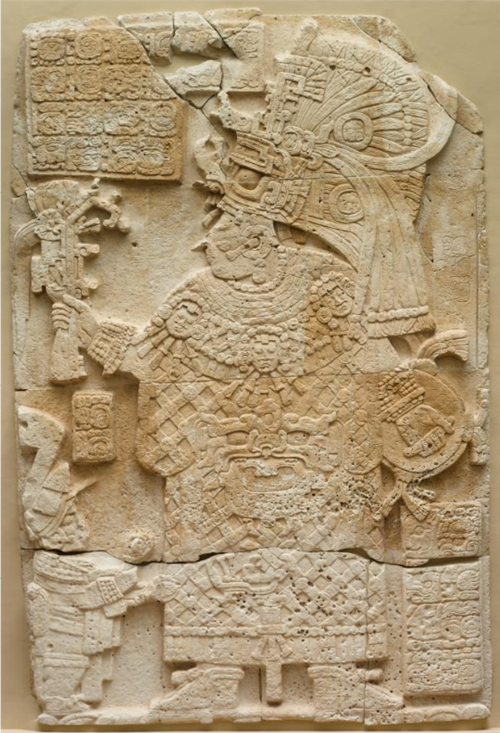
Check out Kaloomte’ K’abel’s stature as represented in her stela! Depicted in a mixed profile and frontal view, she is decked out with adornments such as an elaborate feathered mask headdress, large ear flares, latticed fabric huipil garment, necklace of royal faces, belt depicting a deity, a shield, and an immense scepter. An elaborately adorned short-statured person stands beside her in the bottom left, holding two objects each in an outstretched hand. This figure wears distinct regalia that indicates he is a court attendant and the hieroglyphic inscription just above his head records his name as Pah Tuun Ahk. Review “Who Came Before Us?” to read about what the other two larger text blocks document.
As in this somewhat abstracted portrait of Kaloomte’ K’abel, Maya artists favored idealized facial features, such as long noses that created a straight line from the forehead. They used mixed views like this to present as much information about a subject as possible. They combined figural forms and texts as visual composites. In some cases, Maya artists focused on more naturalistic renderings. Check out this small 3D figurine in ceramic to consider the representation of Maya women in more realistic fashion. These were the sort of arts that inspired early archaeologists to apply the term ‘Classic’ to a portion of Maya history. However, Maya art overall is known for characteristic abstraction, as seen in this stela or the Maize God Mural in “Will You Tell A Story?”. You can learn more about ancient Maya women from many different perspectives in Ancient Maya Women (Ardren 2002).
Gods Above Us All
There is another plane of hierarchy that goes beyond family, kings, queens, and even emperors. As discussed above, the Ife king was divine. He was a god on earth. This merging of political and religious power is relatively common among human societies. Entities that are fully supernatural, with no mortal component at all, often surmount earthly hierarchies, having more power, wisdom, energy, etc. than any other entities. All cultures have their own systems of divine hierarchy, some polytheistic (many gods), some monotheistic (one god), and some pantheistic (everything has a divine force; like in Sikhism or Japanese Shintō). Oftentimes, the social hierarchies that we mere humans strive to climb relate to and/or are dictated by spiritual hierarchies.
The Lega people of eastern Central Africa (Fig. 13.1; present-day Democratic Republic of the Congo) worship a divine triumvirate (group of three main deities), each with their own supernatural role. Kalanga is the promiser who aids mortals in acts against their neighbors (traditions often referred to as sorcery by Western scholars). Kenkunga is the reassembler while Ombe is the hidden. Outside Lega culture, little is known about these deities, especially Kenkunga and Ombe. This lack of information is due to the Lega Bwami society.
Remember the Kòmò society we discussed in “What is Important to Us?” Like that society (within a society), the Bwami society has its unique goals, focused on degrees of community power, reflected in one’s attainment of hierarchical social status. The Lega have village chiefs that hold mundane power but the Bwami society offers a pathway towards spiritual power, probably associated with developing closer and closer ties to Kalanga, Kenkunga, and/or Ombe. Bwami society workings are very secret, especially as one reaches to higher levels, but any Lega person has the opportunity to join voluntarily. One’s journey in the Bwami society often relates directly to one’s wealth because upward movement requires payment. (Currencies have differed overtime, from agricultural products like manioc and banana to iron ore and now gold.) Despite the monetary costs, Bwami Society has great benefits, including “teach[ing] filial respect, marital fidelity, nonviolence, and cooperation” (Cameron 2002, 48).
Many-headed Figure (Fig. 13.11), sometimes referred to as a “Janus Figure” (but not associated with the character of Janus in Roman mythology), is an object of the Bwami society. Carved of ivory, this figure has two heads, each with two faces, stacked atop abstracted limbs. Drilled dots accentuate the edges of heart-shaped faces, characteristic of Lega depictions. Long, slim noses frame deeply set eyes, with lids that protrude to slit-like eyes. Pointed chins exaggerate the heart-shaped forms and appear like pointed mouths, though no mouth opening is present.
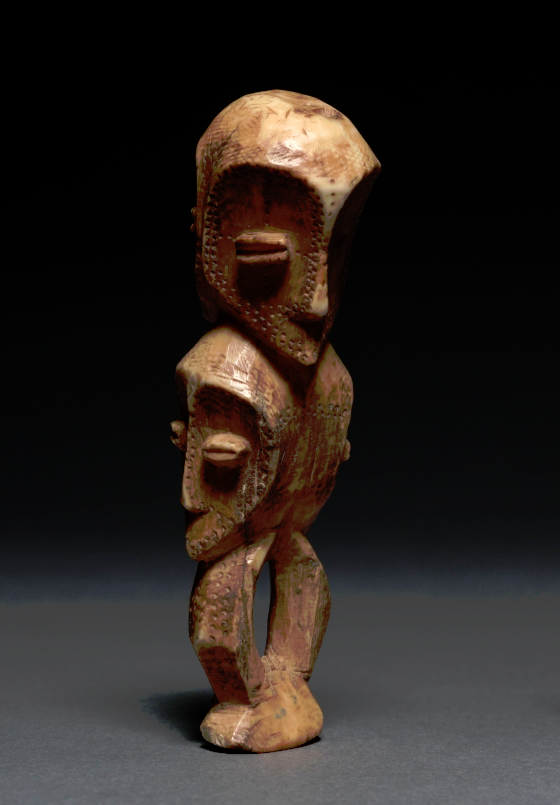
The use of ivory for this sculpture indicates that it was associated with one of the highest levels one could attain within the Bwami society. Lesser objects were carved of wood. Objects focused on human heads like Many-Headed Figure probably relate to the importance of the skulls of ancestors in the most secretive parts of the Bwami society. In particular, multiple heads in this depiction reference the wise Sabitwebitwe of Lega myth. Like Sabitwebitwe, elders of the Bwami society attain great wisdom, as if they could see out of many sides of their head. Scholars also find that the most abstracted and complex a sculpture is, the more likely it is to feature in ceremonies reflecting the highest levels of knowledge and secrecy within the Bwami society, because the features can be read in many different ways.
In addition to their unique spiritual/political structure of the Bwami society, the Lega also have a unique view of objects and art itself. As scholar Carolyn Dean (2006) writes in her article entitled “The Trouble with (the term) Art,” the Lega use the term masengo to describe objects like Many-headed Figure. Translating to “heavy things,” this title is given to items that “exist apart from mundane activities and are endowed with special powers…” (ibid, 26). What scholars call “art” is valued beyond aesthetics or social meaning by Lega people. Masengo are objects of supernatural importance, with spiritual weight and gravity within Bwami society. Scholars like Dean (2006) suggest that the term “art” does not do justice to the value of masengo for the Lega. These issues often lead to questions about whether objects like Many-Headed Figure, now held at the Cleveland Museum of Art, should be on display and/or owned by any group other than the Lega. We will discuss these ideas more in “Why Do People Take What Doesn’t Belong to Them?”
Speaking of taking, let’s discuss the relationship between the Lambayeque and the Chimu. On the northern coast of present-day Peru (Fig. 13.1), the Lambayeque culture (also known as Sicán) thrived for hundreds of years as descendants of the Moche. They honored a (probably mythical) figure called Naymlap, represented in the Tumi (Fig. 13.12). Standing in regal attire, with fanned headdress, large earflares, and arms on his stomach, Naymlap founded Lambayeque by sailing from the south to the north and landing in their eventual territory. After the founding, Lambayeque became known for their artistic style and prowess in metalworking and use of special materials like turquoise.

Then, around 1375 CE, the Lambayeque were overtaken by the growing Chimu Empire (also known as Chimor). At the Chimu capital called Chan Chan, and many other strongholds, captured Lambayeque artists were organized into workshops for producing high-quality artworks for their Chimu overlords. The Chimu ciudadelas were walled palatial compounds with huge storage areas for tax revenue, royal burials, and the workshop quarters were prized Lambayeque artists were highly isolated. In addition to their labor, the Chimu took Lambayeque legend for their own. Naymlap became a Chimu mythical hero. His image adorns this Tumi, a ceremonial (non-functional) knife worn by Chimu elites. The workmanship and imagery is Lambayeque, but the object is Chimu.
In addition to the mythical/spiritual focus on Naymlap, this example shows that social disparity is not just internal to individual societies but can play out cross-culturally. In this case, the Chimu conquered the Lambayeque and instituted a hierarchical system of leadership over that previously independent culture. In other words, the Chimu colonized the Lambayeque. Colonization often creates the ultimate forms of social disparity, where colonizers have power and the colonized do not.
One of the most horrific examples of colonization occurred not too far from the Lega people discussed above. In 1885 CE, King Leopold II of Belgium established the “Congo Free State” in Central Africa. This was a unique colonial situation. Rather than being controlled by a colonizing nation (like Britain, France, Germany, etc.), the Congo Free State was in theory “free and open” to all business endeavors from any nationality and was personally owned by Leopold II. It was anything but a ‘free’ state.
Leopold II was interested in forest resources such as palm oil and rubber. To extract as much as possible, colonial officials of the Congo Free State created a system of labor that sanctioned violence. For example, if a man could not provide the quota of rubber required of his family, officials could cut off his ear, cut off the hands of his children, rape or take hostages from his family, or burn down his village. Other quotes focused on mineral mining through the Congo. The violence and terror of the Congo Free State is thought to have escalated to a point that half of the population was killed (some estimates of up to 10 million people), amounting to a genocide. Eventually in 1908 CE, the Belgium parliament stepped in, removing Leopold II and those willing to follow his orders of violence. Despite these changes, the Belgian Congo, as it came to be known, still perpetrated violence and exploitation against native populations.
While the history of the Congo Free State relates to our considerations of how far the question of “why do they have more than us” can go, it also relates directly to the art world. One result of Leopold II’s colonial venture was the Royal Museum for Central Africa in Brussels, Belgium, established in 1898 CE. In its original form, huge exhibition spaces displayed innumerable objects from the Congo Free State, such as Lega masengo, of immense cultural value to Central African peoples. To learn more about the Congo Free State, check out European Atrocity, African Catastrophe: Leopold II, the Congo Free State, and its Aftermath (Ewan 2002) and King Leopold’s Ghost: A Story of Greed, Terror, and Heroism in Colonial Africa (Hochschild 1999). With a recent renovation, the galleries appear more modern, and there are attempts at contextualizing the violent history and its legacies, but the question remains: is this museum justified, given its implication in the horrors of social disparity? We’ll consider this question deeply in “Why Do People Take What Doesn’t Belong to Them?”
The Wrap-up
Our thoughts are often comparative. We ask “why do they have more than we do.” This is a natural response to inequality and sometimes these questions lead to change. For example, if civil rights activists in the US hadn’t asked why do white people have more than black people, this country’s history would have been very different. That history isn’t perfect and we are still dealing with the need for equity in society today. But the questioning of inequality is the starting point. We can ask it directly in our own lives and we can ask it of the past, around the world. Social disparity is not confined to white and black people in the US. Examples included in this chapter certainly demonstrate that. If these issues hit close to home or spark an interest, make sure to check out the resources and academic readings below to contextualize your personal experience.
News Flash
- The Disney Studios movie “Mulan” supposedly was set in the Han Dynasty, incorporating many tenets of the Confucian tradition. EXCEPT… MULAN NEVER WOULD HAVE CUT HER HAIR!!
- The Lewis Chess Men inspired the wizard chess set played by Harry Potter and Ron Weasley in the film Harry Potter and the Chamber of Secrets, based on the book by J.K. Rowling.
- Emperor Akbar and the Mughal Empire feature in the 2008 Bollywood historical drama Jodhaa Abkar.
- Chimu (and Lambayeque) art styles feature in The Emperor’s New Groove by Disney Studios (but, problematically, they are conflated with many other ancient Andean art styles).
- In addition to the academic books about “Congo Free State,” there are two documentaries: “King Leopold’s Ghost” directed by Pippa Scott and “Congo: White King, Red Rubber, and Black Death” directed by Peter Bate.
Where Do I Go From Here? / The Bibliography
Ardren, Traci (ed). 2002. Ancient Maya Women. Lanham, MD: AltaMira Press.
Frobenius, Leo. 1913. Voices of Africa. 2 vols. New York: Benjamin Bloom.

